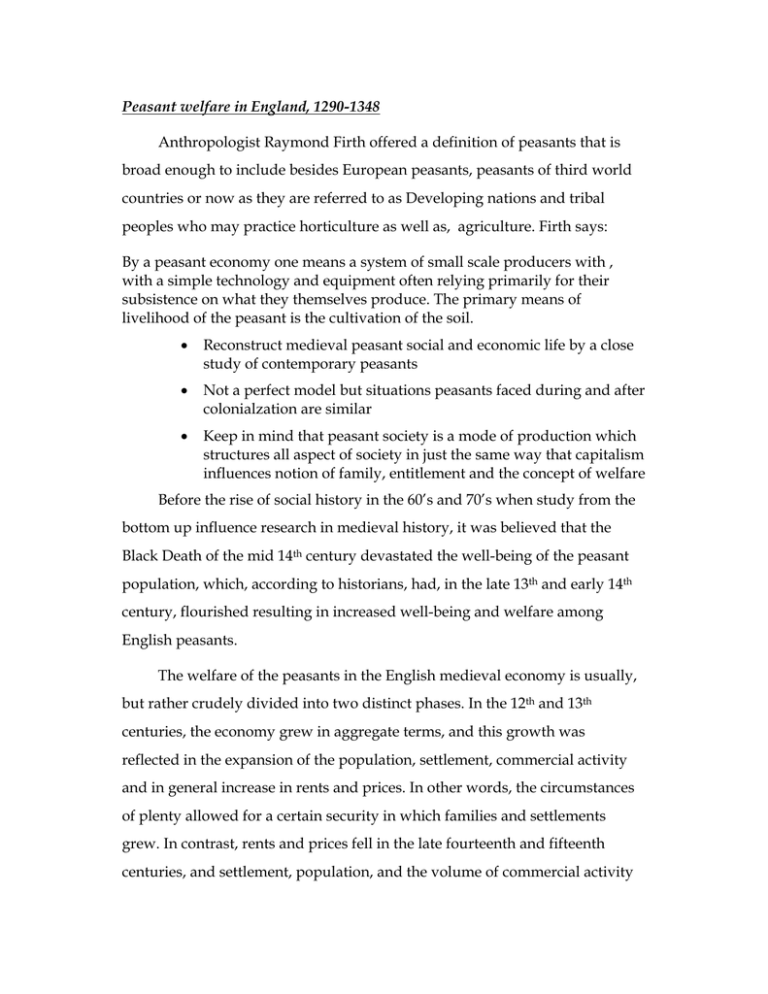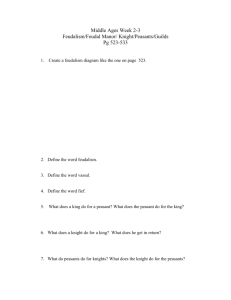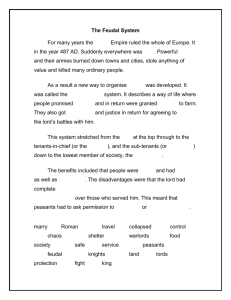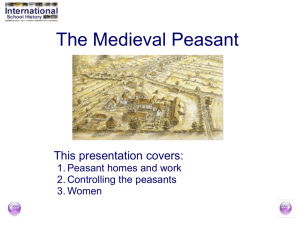Peasant welfare in England, 1290-1348
advertisement

Peasant welfare in England, 1290-1348 Anthropologist Raymond Firth offered a definition of peasants that is broad enough to include besides European peasants, peasants of third world countries or now as they are referred to as Developing nations and tribal peoples who may practice horticulture as well as, agriculture. Firth says: By a peasant economy one means a system of small scale producers with , with a simple technology and equipment often relying primarily for their subsistence on what they themselves produce. The primary means of livelihood of the peasant is the cultivation of the soil. • Reconstruct medieval peasant social and economic life by a close study of contemporary peasants • Not a perfect model but situations peasants faced during and after colonialzation are similar • Keep in mind that peasant society is a mode of production which structures all aspect of society in just the same way that capitalism influences notion of family, entitlement and the concept of welfare Before the rise of social history in the 60’s and 70’s when study from the bottom up influence research in medieval history, it was believed that the Black Death of the mid 14th century devastated the well-being of the peasant population, which, according to historians, had, in the late 13th and early 14th century, flourished resulting in increased well-being and welfare among English peasants. The welfare of the peasants in the English medieval economy is usually, but rather crudely divided into two distinct phases. In the 12th and 13th centuries, the economy grew in aggregate terms, and this growth was reflected in the expansion of the population, settlement, commercial activity and in general increase in rents and prices. In other words, the circumstances of plenty allowed for a certain security in which families and settlements grew. In contrast, rents and prices fell in the late fourteenth and fifteenth centuries, and settlement, population, and the volume of commercial activity all contracted. This contrast in economic fortunes poses a significant question: when did the change first occur and why? The first thing that comes to mind was the Black Death—the spread of bubonic plague across Europe in 1348-9. Others now have suggested that the economy was already exhibiting clear signs of decisive change in the 50 or so years before the Black Death. So was the plague merely an accelerator of trends, already in motion? Why should we care about the experience of peasants in 13th and 14th century England? I would answer that the peasants of the 13th and 14th century England were faced with matters concerning survival not unfamiliar to peasants in contemporary period when the size of their land under cultivation is reduced. For example, in Central America, land allocated for subsistence production is held communally—it can be leased but not sold. With the advent of globalization and the expansion of commercial agriculture the land of indigenous people—like the Mayans and Aztecs—have no legal claim to their land other than custom and tradition. So as the land available for cultivation shrinks per household, the peasants are forced to make some decisions to maximize the productivity of the land. The strategies available to contemporary peasants in Central America are like the strategies available to peasants in 13th and 14th century England. There is no doubt that the years between 1290 and 1348 were exceptional. Levels of medieval population and commercial activity peaked at some point in this period while mean size of holdings and real wages fell to their lowest levels. Simultaneously, the economy suffered a series of extreme and onerous shocks, principally a succession of severe harvest failures and prolonged military activity, which resulted in the widespread destruction of property in the northern counties and heavy and persistent levels of high taxation by the crown throughout England. Due to problems with the sort of documentary evidence available and the limitations of a generalist economic approach, it appears better to explore the subject from an anthropological approach, which assess the position of the peasantry on a local level, by collecting, collating and fitting into a comprehensive pattern all pieces of information or impressions obtained from documents. Encouragement for this approach is provided by the large body of local sources which are from this period but largely were unexplored. They do provide some insight into activities such as peasant production, occupations, commerce, the land market, and indebtedness which, when tweaked with ingenuity, does shed some light on peasant welfare. Here it is important to recognize that “peasant welfare” can not be gotten to directly with any precision and ultimately the factors that comprise welfare are derived from the present and not the past—how would a peasant him or herself identify “welfare” remains a partial mystery. However, it is certain that income and landholding available for subsistence production are telling indicators of peasant welfare. Household income is a primary factor of peasant welfare. Anthropologists and Economic-Historians have established that peasant household expenditure substantially increased during the course of the 13th century. Although the size and composition of households varied, the cost of clothing and feeding the average person more than doubled between the first and last decades of the 13th century and sustained population growth meant more mouths and households to feed. Rents, another index of peasant welfare rose significantly. Such rises did not occur evenly throughout the country, and for some tenants may not have matched the rise in land values, but in general land rents rose at least as much as the cost of living in the course of the 13th century. Based on this information, we can conclude that mean household income had to increase by the same extent if standards of living were to remain constant. Under the circumstances of the increases in population and settlements, if household income appears to remain constant or falls, then the levels of welfare must have declined considerably towards the end of the 13th century. To establish mean household income is difficult to asses because the sources of income in medieval households are both obscure and eclectic. Economic Historians have made two assumptions in this regard. The first is that household income normally included both monetary and non-monetary contributions and that the peasantry derived the bulk of their household income from three basic sources: a landholding, common rights, and/or employment, although the exact balance would obviously vary according to local and personal circumstances. The most common factor was a landholding and its yield of grain since grain was the most important commodity in the medieval economy and the vast majority of the population sought a living of some sort in agriculture. The second assumption follows from the first. If household income is derived predominantly from a combination of landholding, common rights and employment, then any changes in their availability ought to have a negative impact on household income. For example, the most striking tendency relevant to household income was the fall in holding size during the course of the 13th century. Historians have established that both the mean and median size of holdings declined on manor after manor and only few places show a rise in mean holding size. It is interesting to note the impact of ever smaller landholding. Certainly the proportion of people dependent upon smallholdings grew, so that by 1300 perhaps two-thirds of peasant households depended for their livelihood upon small or even miniscule holdings. Given a fall in mean holding size, or a failure of mean holding size to increase in the context of the general rise in household expenditure, the most obvious consequence would be a reduction in mean household income and welfare What was the peasant’s reaction to a fall in mean income? Peasants devised certain strategies to protect, or even raise, their household income. Though the land may be scarce, if labor increased then the limited land area could be more productive. Thus by increasing the amount of family workers or perhaps hired labor, a peasant might expect to raise land productivity. Evidence of the value of this strategy comes from contemporary times in India where the efficiency of small farms operated by family labor where yields compare favorably with those on larger landholdings. Data for land or labor productivity on peasant holdings are found in manor records. These records indicate that peasants usually yielded between 8 and 15 bushels per acre, although some consistently achieved over 20 bushels. There is some evidence that productivity increased by reducing land left fallow. How else might peasants compensate for declining landholding size? One strategy might have been the sowing in their land higher yielding crops, such as barley, or more marketable and valuable crops such as wheat or industrial crops—Flax and Hemp. By growing and selling high value crops, and buying cheaper grains for their own consumption, peasants might increase income from the holding. Industrial crops were not commonly sown as field crops before the Black Death, although it is possible that their use in peasant gardens may have increased. Flax and hemp were widely sown in the 1340’s. Evidence for peasant grain preferences is fragmentary, but a commitment to the most marketable crop is readily seen For example, manor records show roughly equal quantities of rye, barley and oats where sown on the manor, in contrast to local peasants who concentrated on more saleable barley while the wealthier peasants specialized in malt grains. Lastly another option was to reduce the fallow area and thus increase the regularity with which land was sown and would obviously raise the output of the holding even if grain yields per acre remained constant. Though not directly related to land cultivation, there were other options to increase income associated with landholding. Landholdings carried rights to graze animals on common fields and pastures, to glean corn and to extract timber from woodlands or peat and fish from marshland. The extent of such rights obviously depended on the size of the holding and the extent of natural resources but they offered another potentially vital source of income to landholders experiencing a reduction in land size. In pasture rich regions, livestock contributed vitally to peasant income. Similarly, the acquisition of a few sheep could provide welcome income from the annual crop of wool, a high-value commodity with an international market and the odd cow, pig or poultry provided a valuable supplement to the peasant economy. So as we see there where a number of strategies available to peasants to offset the decline in landholding, and most importantly, options that not only increased income but maintained standards of living. An option yet to be explored is that of employment off the farm. This option could make a substantial contribution to peasant income, although, again their importance is almost impossible to quantify. Yet there can be no doubt that the range of occupational opportunities and availability of waged employment increased during the course of the 13th century. Such opportunities were especially evident in towns, but the diversity and extent on non-agricultural employment in the countryside was considerable and ranged from brewing and milling to craft and artisan work. Peasants need blacksmiths! What is certain is that the number of households which depended on waged employment and by extension depended on the market for basic food stuffs grew during the 13th century. What is the basis of this certainty—firstly, the scholarship of economic historians and secondly, the strategies described are found in contemporary peasant societies. We must keep in mind that peasant society is an economic system which relies on strategies for survival and patterns of decision making for the welfare of the family Perhaps the final strategy for addressing a fall in holding size was to reduce the size of the household in order to tailor expenditure to income. We find this strategy later on in the 18th and 19th century Ireland. We can suppose that the tightening of household budgets might result in attempts to either hold constant or reduce the size of the household through celibacy, later marriages, sexual restraint within marriage or the migration of sons and daughters to towns. This latter strategy was undertaken only as long as the lost of land workers did not reduce the productivity of the land. We should now turn to ways the peasants landholders were not capable of compensating fully or even partially—for diminished farm size. Simply stated in order for peasants to produce a constant supply of grain in the face of declining landholding size, productivity had to be increased. This posed particular problems for small landholding peasants because a decrease in the size of their land would require large increases in yields per acre. The ability to increased labor inputs is greatest on family farms with a surplus labor force, for which few other laboring opportunities exist. Yet the availability of alternative employment presented peasants with something of a dilemma, for they had to decide whether the potential benefits of employing their spare labor on the farm were greater than those of obtaining work elsewhere, and whether the search costs of employment were sustainable. Other factors also prevented peasants from applying family labor to the farm at will. Unfree landholders owed varying amounts of labor on manors to an extent which could influence significantly the length of their working year in some places. Cultural activities, such as festivals and religious holidays, also placed considerable restraints on working practices on a regular or seasonal basis. Anthropological Historians and medieval historians both estimate that cultural and social commitments effectively reduced a laborer’s working year to 260 days. Furthermore, the claim that peasants can increase their work intensity on the holding at will assumes that they are sufficiently nourished, yet development economists and anthropologists have argued that underfed African peasants are less able to increase work intensity in key seasons. Clearly, then, it is obvious that there are factors that show why peasants could not always increase labor on the holding at will, and we must be aware of making the wrong assumption that the opportunity cost of family labor was zero. Even if additional laborers on the land could be increased, there are grounds for supposing that their benefit to levels of land and labor productivity would eventually be marginal without clear evidence of other investments made on the land. Some improvement in land productivity is possible under these circumstances, but it is unlikely that it would be significant Let’s consider the value of non-agricultural employment as a means to increase income. The importance of craftwork and waged employment as alternative sources of income around 1300 cannot be judged solely on evidence that such work had become more widespread, because the supply of labor had also increased. The key issue is whether the available work was sufficiently widespread and consistently available to meet the demands of the workforce, and whether it was well paid. Real wage data from the late 13th century point strongly to a serious oversupply of labor, and economic historians acknowledge the real difficulties faced by laborers: low rates of pay, limited and discontinuous work opportunities and heavy competition for any available employment, which collectively casts doubts on the ability of households to increase non-agricultural income sufficiently to compensate for any decline in other areas of household income The difficulties in balancing household budgets were most severe on the smallest landholdings, and by 1300 smallholders dominated the landholding and social structure of England, especially in the southern and eastern regions. For example, 1n 1298, 74 percent of tenants in Norfolk held under 5 acres. The potential liabilities of these fragmented landholdings are manifest. First, because they were unable to produce sufficient food to meet their own subsistence requirements, smallholders were adversely affected by the rising cost of living. On the one hand they were unable to grow enough grain to generate much income from sales, and on the other hand, they were forced to enter the market to purchase food for their own consumption; in contrast large landholders could produce enough grain to feed their household, and sell a surplus at good prices. Secondly, their overheads tended to be relatively higher because small landholders were often charged higher rents per acre than tenants of larger holdings. A key element influencing the ability of the peasantry to defend their income against the fall in landholding size is the nature and impact of commercial change. Commerce could stimulate rises in productivity on the holding, greater and more reliable income from the sale of produce and increased earnings from employment. It is widely accepted that commercial developments in the 13th century meant that the majority of peasants were involved in marketing activity of some sort, because nearly everyone enjoyed access to a weekly market, which offered a ready means of selling their produce and nearly everyone needed to enter the market in order to obtain cash to pay their market rents, fines and taxes. As we see today, a welldeveloped market economy could increase the level and regularity of income through the sales of produce and supply foodstuffs at relatively stable prices to smallholders, the landless and urban dwellers Development economists usefully distinguish between a planned commercial strategy to describe the production of cash crops specifically for market, and an unplanned strategy where a peasant sells any surplus, or is forced to sell produce on an ad hoc basis. In the absence of reliable data, we can only speculate, that, on the eve of the Black Death, only 10 percent of England’s arable land was given over to cash crops, and that the vast majority of peasant produce was sold primarily to raise cash for rents rather than for the advantages which markets could bring producers. Wealthy peasants were more likely to pursued planned strategies The historical record shows that rent increases usually followed bad harvests. How did peasants survive such crises? In particular, how did the many smallholders for whom the problem posed by persistent harvest failure were especially grave, fare under repeated onslaughts? The immediate response of most peasant households to conditions of harvest failure and high taxation would be to eke out existing stocks of food, especially grain and to supplement them with inferior substitutes and plants. Therefore they would have to draw upon any savings, and then, if absolutely necessary, to liquidate their most saleable assets. Livestock provided an obvious source of food or ready cash, but stocks were repeatedly decimated in this period due to disease. The increasingly feverish activity of local land markets during crisis periods is a sure indicator that many peasants had drawn on their reserves, because sale of land is self-evidently a drastic measure. And if land was being sold to pay off debts or purchase food, then it seems certain that tools, utensils, seed corn and livestock were also sold or consumed. The economic devastation ,during and following the Black Death , prevented effective relief. Starving households only hope of survival rested in charitable relief. Before the Black Death, rural charitable relief was provided by kin. We know this to be the case by the absence of those institutions such as monasteries which took feeding the hungry as part of their ongoing duties and almshouses. But if charity was kin based, then it is difficult to see how it provided any effective relief of rural poverty when many households were suffering diminishing resources. Furthermore, the social group most in need of relief-smallholders-invariably had a low density of kin residing locally. Monastic alms giving was not prominent and certainly declined in feminine years and manor accounts do not indicate much local alms giving by landlords. The peasants had no safety net. I have used peasant income for exploring peasant welfare before the Black Death. Specifically, I have suggested that welfare is best approached through careful assessment of the rate and tendency for changes in household income and expenditure at the local level where variations in lordship, social structure and economic conditions can be best evaluated. The most important characteristics of the English economy in the 14th century were a volatile market system and a landholding structure dominated by smallholders, a combination which exposed the mass of the peasantry to considerable degree of risk Thus, it is now widely believed that English society and economy were already in the midst of major change and economic crisis before the on-set of plague due to a decrease in household income. There is currently the belief that the Black Death did relatively little to speed the process of decline. In fact the reverse happened. Despite the enormous death-rate many aspects of life have been shown to have reverted swiftly and powerfully towards normality: within a few years of 1350 the land was almost fully occupied and at rents which stood comparison with former years; instead of collapsing manor cultivation and serfdom survived; the incomes of landlords were sustained a surprising high levels and their was healthy growth in urban centers and commercial and industrial life. It is also the case that in the generation after the first plague the gap between the richer and poorer members of village communities widened as the upper and middle strata prospered disapportionately, primarily because the great majority of the numerically dominate smallholders, cottagers and landless lacked the resources to take full advantage of the opportunities for advancement which were created. Although money wages rose in the generation after 1348-9 so did the prices of almost all basic goods. The net result was that, in a period of acute labor scarcity, the real rewards of laborers, servants and artisans improved only marginally if at all. The survivors of the Great Plague of 1348-9 were in no doubt that the fortunes and demeanor of the lower strata had been transformed. In the experience of the upper strata of society, the trauma of successive waves of devastating pestilence was followed by the prolonged discomfort inflicted by empowered tenants and workmen who, conscious of the prospects for betterment which the massive mortality had placed within their grasp, would not be coerced into placidly accepting their time honored subservient roles as the meek providers of ample rents and cheap labor.





